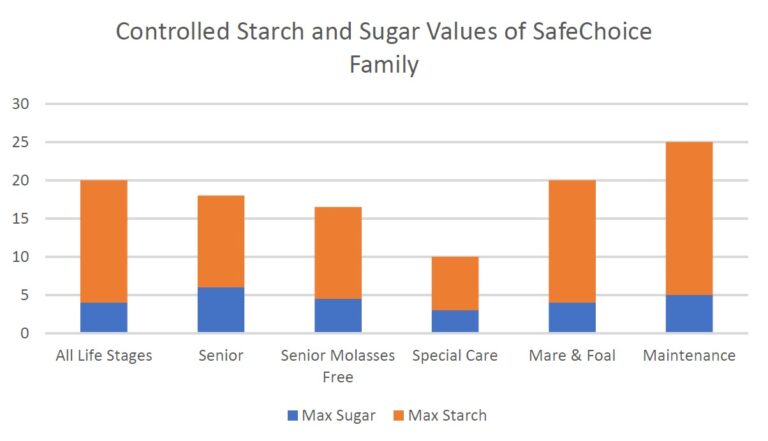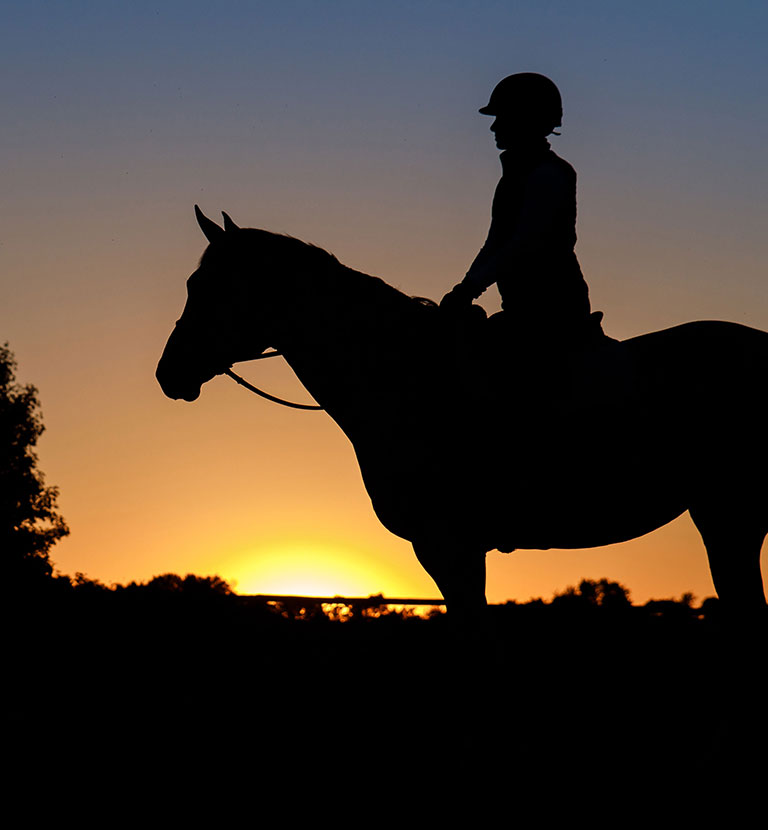Controlled Starch
The Importance of Controlled Starch
The Nutrena brand changed the feed industry over 20 years ago with the debut of the original SafeChoice Horse Feed, the first-ever controlled starch horse feed to hit the market. Prior to the launch of the original SafeChoice feed, unknown starch and sugar content levels were the norm in the feed industry. While starch and sugar are effective and efficient calorie sources in horse feeds, excess intakes per meal, particularly for starch, can lead to problems in the horse. By “controlling” and setting maximums on the starch and sugar levels, our SafeChoice horse feed provided a new direction in the feed industry and helped reduce the prevalence of digestive concerns for a wide variety of horses.
Why Is Uncontrolled Starch Risky?
In 1992, a study at Texas A&M University reported that if more than 4 g of starch/kg of body weight/meal was fed, excess amounts of starch passed the small intestine and entered the cecum and large intestine1. When undigested starch enters the hind gut, the pH drops, microbial populations change, and other digestive upsets can occur, such as loose stools, colic, and laminitis2. Staying below this starch intake threshold is critical to maintaining a properly functioning hind gut.
With that in mind, if the starch content of a feed is unknown, it is difficult to ensure you are feeding a starch level appropriate for the horse. To put this information into a real-world scenario:
- Corn has an average of 72% starch and feeding 6 lbs of corn in a single feeding to an 1100 lb horse would exceed the 4 gram maximum.
- Oats have an average of 43% starch and feeding 10 lbs of oats in a single feeding to an 1100 lb horse would exceed the 4 gram maximum.
Unknown or uncontrolled starch and sugar levels can bring additional complications at feeding time. Accidental overfeeding of high starch feeds can easily lead to exceeding the levels above the threshold and create serious problems in the horse.
The Nutrena brand continues to be the leader in guaranteeing maximum levels of both starch and sugar levels, and all SafeChoice feeds are designed with the intent of the original SafeChoice product in mind supporting a healthy digestive tract and offering horse owners everywhere peace of mind.
What About Horses with Metabolic Conditions?
For horses that have various metabolic conditions, such as Equine Metabolic Syndrome (EMS) or Pituitary Pars Intermedia Dysfunction (PPID), glucose regulation in the body can be negatively affected because of insulin resistance3. After a meal, both starch and sugar digested in the small intestine result in glucose entering the bloodstream. The hormone insulin then rises signaling the body to uptake the glucose into cells for use or storage. In horses with metabolic conditions this rise in insulin is essentially ignored, meaning cells are resistant to its effect and resulting in high levels of glucose in the bloodstream. This, in turn, can have negative consequence to horse health, especially when sustained over extended periods.
For horses with these types of metabolic conditions, having an even lower than normal starch and sugar intake is beneficial to limit the amount of glucose the horse must regulate. While little formal research has been conducted to determine a threshold for horses with these conditions and recognizing that threshold may vary from horse to horse, a typical recommendation is to consume less than 10% non-structural carbohydrates (NSC; sugars and starches) in the total diet. Horse owners should monitor all dietary sources of sugar and starch, including forages, which, due to volume consumed daily, can often provide more starch and sugar than feeds do. When calculating total dietary NSC, then, it is important to consider the contributions of all dietary components and not simply consider the percentage present in each individual feedstuff.
Through the products in the SafeChoice family of feeds, horse owners have a variety of options when it comes to starch and sugar levels – including SafeChoice Special Care, which is designed with these metabolic conditions in mind. SafeChoice Special Care is now formulated to contain a maximum of 7% starch and 3% sugar for a total NSC of 10%.
Is All Starch and Sugar Bad?
When it comes to performance and working horses, starch and sugar are still very efficient sources of calories and support replacement of glycogen stores within muscle (also known as glycogen repletion), especially when formulated along with fat and oil sources. The type of work the horse is participating in determines the type of calorie sources that horse may need.
- Horses working at a lower intensity for a longer duration (western pleasure, hunters, dressage, trail riding, etc) may not need extra starch or sugar, and fat is a preferred source of calories.
- Horses that are competing in speed type events (racing, roping, cutting, barrel racing, etc) where the intensity is higher and faster and the duration is shorter, the body actually requires additional starch and sugar, and the resulting glucose is its required calorie source.
Thus, the “lower is better” thinking does not apply to all horses, and often a reduction in dietary starch and sugar levels could result in certain disciplines of horses not performing up to expectations!
With that in mind, the SafeChoice family of feeds offers an array of options, from the All-Life Stages formula designed to support performance to the low sugar and starch of Special Care.
The SafeChoice Difference
While SafeChoice pioneered the starch and sugar trends over a decade ago—it has never focused on being the “lowest” starch and sugar feeds on the market. What the SafeChoice products deliver is the control, and the options, for horse owners to choose feeds with the proper starch and sugar content for their horse and their needs.
SafeChoice All Life Stages has a combined starch and sugar of 20% with a max sugar of 4% and maximum starch of 16% declared right on the tag. If we applied the 4 g of starch/kg bw/meal data from above—you could safely feed 27 lbs of SafeChoice All Life Stages to that same 1100 lb horse and not have starch reach the hindgut—although no horse should require a single meal that large.
SafeChoice Special Care with a combined starch and sugar level of 10% is the lowest level in the SafeChoice line up and would be the best choice for horses with metabolic concerns. The rest of the SafeChoice family of products has various controlled starch and sugar values shown in the chart below, giving you a wide variety of options to meet the specific needs of your horse.

The SafeChoice family is about supplying horse owners the options the need for controlled starch and sugar levels. We declare our values right on the tag to provide peace of mind that each horse is getting what it truly needs.
References
*Excludes SafeChoice® Maintenance Feed
1Potter, G. D., et al. “Digestion of starch in the small or large intestine of the equine.” Pferdeheilkunde 1.4 (1992): 107-111.
2Cuddeford, D. E. R. E. K. “Starch digestion in the horse.” Advances in equine nutrition II (ed. Joe D. Pagan and J. Geor). Nottingham University Press. Thrumpton (2001): 95-103.
3Reed, Stephen M., Warwick M. Bayly, and Debra C. Sellon. Equine Internal Medicine-E-Book. Elsevier Health Sciences, 2017.
4Cargill Animal Nutrition Internal Research Trial. University of Wisconsin-Falls. 2012
Get a FREE Consultation
Fill out our Contact Us form for an equine nutrition expert to provide 1-on-1 recommendations for your feeding program.




